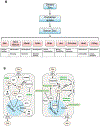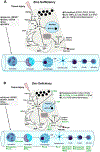Zinc: Roles in pancreatic physiology and disease
- PMID: 32917512
- PMCID: PMC7572834
- DOI: 10.1016/j.pan.2020.08.016
Zinc: Roles in pancreatic physiology and disease
Abstract
Zinc is an essential trace element. Deficiencies are frequently seen with gastrointestinal diseases, including chronic pancreatitis, nutritional deficiency, and reduced intestinal absorption. Additionally, reduced zinc levels have been linked to cellular changes associated with acute pancreatitis such as enhanced inflammation with increased macrophage activation and production of inflammatory cytokines such as IL-1β, impaired autophagy, and modulation of calcium homeostasis. Preliminary data suggest that zinc deficiency may lead to pancreatic injury in animal models. The purpose of this review is to explore the biologic effects of zinc deficiency that could impact pancreatic disease. MESH KEYWORDS: Malnutrition, inflammation, trace element.
Keywords: Cytokine; Pancreatitis; Zinc.
Copyright © 2020 IAP and EPC. Published by Elsevier B.V. All rights reserved.
Conflict of interest statement
Declaration of competing interest The authors have no financial disclosures or conflicts of interest for this review.
Figures


Similar articles
-
Zinc deficiency in patients with chronic pancreatitis.World J Gastroenterol. 2019 Feb 7;25(5):600-607. doi: 10.3748/wjg.v25.i5.600. World J Gastroenterol. 2019. PMID: 30774274 Free PMC article.
-
Functions of autophagy in hepatic and pancreatic physiology and disease.Gastroenterology. 2011 Jun;140(7):1895-908. doi: 10.1053/j.gastro.2011.04.038. Epub 2011 Apr 23. Gastroenterology. 2011. PMID: 21530520 Free PMC article. Review.
-
Nutrition and absorption in diseases of the pancreas.Clin Gastroenterol. 1983 May;12(2):551-62. Clin Gastroenterol. 1983. PMID: 6347468 Review. No abstract available.
-
Zinc status in chronic pancreatitis and its relationship with exocrine and endocrine insufficiency.JOP. 2009 Nov 5;10(6):651-6. JOP. 2009. PMID: 19890187
-
The role of the pancreas in the regulation of zinc status.Biol Trace Elem Res. 1994 Aug;42(2):143-9. doi: 10.1007/BF02785385. Biol Trace Elem Res. 1994. PMID: 7981004
Cited by
-
Zinc status in cystic fibrosis patients; a systematic review and meta-analysis.Heliyon. 2024 Jun 28;10(13):e33686. doi: 10.1016/j.heliyon.2024.e33686. eCollection 2024 Jul 15. Heliyon. 2024. PMID: 39027558 Free PMC article. Review.
-
Hesperidin alleviates zinc-induced nephrotoxicity via the gut-kidney axis in swine.Front Cell Infect Microbiol. 2024 Apr 29;14:1390104. doi: 10.3389/fcimb.2024.1390104. eCollection 2024. Front Cell Infect Microbiol. 2024. PMID: 38741891 Free PMC article.
-
The Solute Carrier Superfamily as Therapeutic Targets in Pancreatic Ductal Adenocarcinoma.Genes (Basel). 2025 Apr 18;16(4):463. doi: 10.3390/genes16040463. Genes (Basel). 2025. PMID: 40282424 Free PMC article.
-
The direct and indirect effects of bioactive compounds against coronavirus.Food Front. 2022 Mar;3(1):96-123. doi: 10.1002/fft2.119. Epub 2021 Dec 8. Food Front. 2022. PMID: 35462942 Free PMC article. Review.
-
Effects of Organic Zinc on the Growth Performance of Weanling Pigs: A Meta-analysis.Biol Trace Elem Res. 2024 Nov;202(11):5051-5060. doi: 10.1007/s12011-024-04070-2. Epub 2024 Jan 23. Biol Trace Elem Res. 2024. PMID: 38253801
References
-
- Prasad AS, Miale A Jr, Farid Z, Sandstead HH, Schulert AR. Clinical and experimental. Zinc metabolism in patients with the syndrome of iron deficiency anemia, hepatosplenomegaly, dwarfism, and hypogonadism. J Lab Clin Med 1963;116(5):737–49. 1990. - PubMed
-
- Prasad AS. Impact of the discovery of human zinc deficiency on health. J Trace Elem Med Biol 2014;28(4):357–63. - PubMed
-
- Alpers DH, Young GP, Tran CD, et al. Drug-development concepts as guides for optimizing clinical trials of supplemental zinc for populations at risk of deficiency or diarrhea. Nutr Rev 2017;75(3):147–62. - PubMed
-
- Eide DJ. The SLC39 family of metal ion transporters. Pflügers Archiv 2004;447(5):796–800. - PubMed
-
- Liuzzi JP, Cousins RJ. Mammalian zinc transporters. Annu Rev Nutr 2004;24: 151–72. - PubMed
Publication types
MeSH terms
Substances
Grants and funding
LinkOut - more resources
Full Text Sources
Medical

